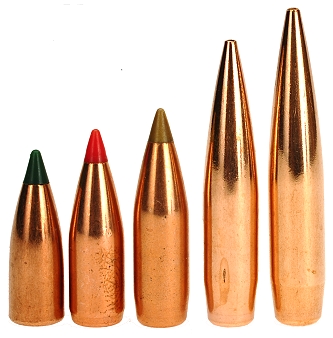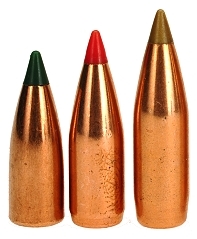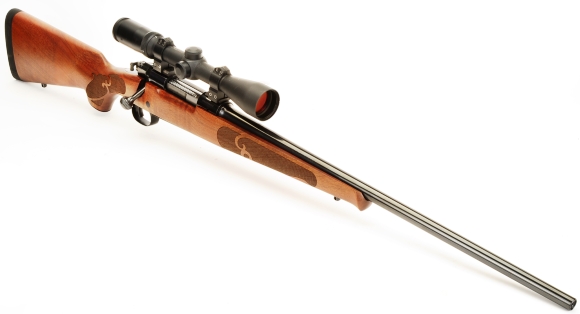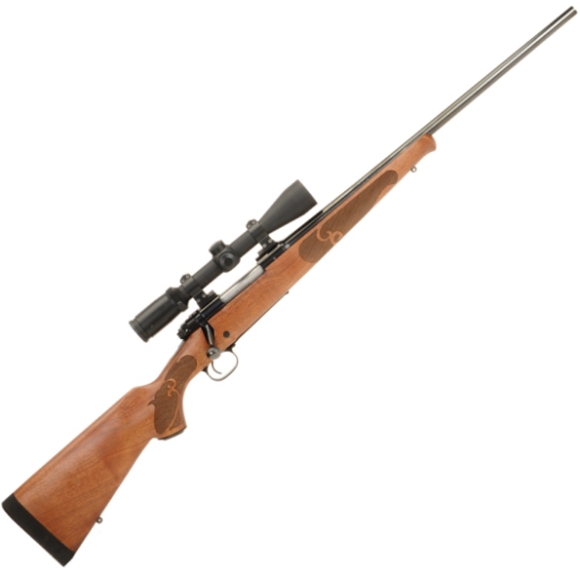06/07/2020
Audio Prologue:
 Apparently, there are places within these United States where large expanses of rolling plains, clumsy herd animals and hole creating prairie dogs intersect to wipe out a rancher’s only source of income; the herd. Surely you have seen splinted cattle, gimping along on a cattle drive with marked down price tags hanging from their horns.
Apparently, there are places within these United States where large expanses of rolling plains, clumsy herd animals and hole creating prairie dogs intersect to wipe out a rancher’s only source of income; the herd. Surely you have seen splinted cattle, gimping along on a cattle drive with marked down price tags hanging from their horns.
In those areas, prairie dog populations are controlled with cartridges like the .22-50 BMG-AI matched with 36″ barrel rifles. Why would they not, as the average shooting distances is 1,200 yards!…!!. In Maine, where cattle and sheep are mostly found in zoos, and modern ranchers raise peacocks and alpacas, varmints come in different forms.
Coyotes decimate our deer herds during periods of heavy snow fall and eat our pets as they recreate on back porches. Fox and skunk contract rabies at a substantial rate and opportunistically bite the hands of Mainer’s, both metaphorically and literally, who insist on feeding them. More common are the gray squirrels that snack on costly structures, and/our vegetable gardens and every grain of seed we plant.
So on my list of varmints are: coyotes that make it a habit of coming out of the woods and hanging out in populated areas, oddly behaving fox and skunk that are flashing teeth at pedestrians in broad daylight and any squirrel in the area of the homestead while I have a firearm in my hand.
A varmint eradication facilitator
|
Winchester Model 70 Featherweight |
|
| Manufactured | Browning – Portugal |
| Item# | 535200212 |
| Type | Bolt Action |
| Caliber | 243 Winchester |
| Capacity | 5+1 |
| Barrel Length | 22″ |
| Rifling | 1:10 RH |
| Weight | 6 Lbs 12 Oz |
| Overall Length | 42 1/4″ |
| Stock | Black Walnut Grade I |
| Barreled Action | Blued Alloy Steel |
| Length of Pull | 13 3/4″ |
| Drop at comb | 1/2″ |
| Drop at heel* | 3/4 “ |
| Sights | Clean |
| Scope | Drilled and Tapped |
| Trigger Pull | 3 Lbs. 11 Oz. Adj |
| Safety | Wing Three Position |
| U.S. MSRP | $1009.99 |
I do not own a Model 70 Winchester Featherweight in 243 Winchester at the moment, but only because I currently own a six pound Model 70 Compact with many of the same attributes. The Compact is in queue for a fancy black walnut stock… as it has been since 1998. The problem is that it is in frequent use and I cannot see taking it out of service for six months. Hmm… perhaps I should buy a Featherweight, get the benefit of two more inches of barrel length and time for fitting a new stock on the Compact?
Some of the attributes that make the Featherweight an ideal candidate are obvious. The smooth, controlled feed action, an adjustable super slick trigger, a swing safety for easy field operation, a very comfortable stock for good control and support, and just enough fancy stuff to instill pride of ownership.
The Model 70 Featherweight also has a 2.880″ long magazine well and a 0.175″ freebore behind the rifling that will accommodate significantly longer than 2.710″ maximum length cartridges. All of this combines to give the handloader more latitude in working toward maximum ballistic performance, velocity and accuracy.

In more tangible terms, the Winchester Model 70 Featherweight can easily accommodate everything from a 0.790″ long Sierra 55 grain varmint bullets to 1.352″ long 115 grain Berger Match bullets. The former seated deeply enough to properly secure the bullet with case neck tension, the latter without deep seating and displacing useful case powder capacity.
Lightweights

| Bullet | Type | Weight Grains |
Bullet Length” |
Cartridge OAL” |
| Sierra BlitzKing | PT | 55 | 0.749 | 2.630 |
| Hornady V-Max | PT | 65 | 0.842 | 2.600 |
| Rem AccuTip | PT | 75 | 0.936 | 2.640 |
Joe, why are you including a Remington AccuTip where there are no mainstream reloading manuals available for us to put your handloads into context? In this case, the Remington AccuTip is actually a 75 grain Hornady V-Max, cleverly disguised with Remington green camo.
Warning: Bullet selections are specific, and loads are not valid with substitutions of different bullets of the same weight. Variations in bullet length will alter net case capacity, pressure and velocity. Primer selection is specific and primer types are not interchangeable. These are maximum loads in my firearms and may be excessive in others. All loads should be reduced by 5% as a starting point for development where cartridges have greater than 40 grains in capacity and 10% for cartridges with less than 40 grain capacity following safe handloading practices as represented in established mainstream reloading manuals. Presentation of these loads does not constitute a solicitation for their use, nor a recommendation.

| Cartridge – 243 Winchester |
|
| Firearm | Winchester M70 Featherweight |
| Barrel Length | 22.00″ |
| Min – Max Case Length | 2.045″ +0.000″/-0.020″ |
| Min – Max COL | 2.450″ – 2.710″ |
| Primer | CCI 200 |
| Bullet Diameter | 0.2430″ +0.000″/-0.0030″ |
| Reloading Dies | RCBS |
| Bullet Type | Bullet Weigh Grains |
Net H2O Grains Capacity |
C.O.L.” | Powder Type |
Powder Charge Grains |
Muzzle Velocity FPS |
Muzzle Energy Ft-Lbs |
100 Yd 3 Shot Group” |
| Sierra BlitzKing | 55 | 52.1 | 2.630 | H414 | 49.0 | 3788 | 1753 | 0.5 |
| Sierra BlitzKing | 55 | 52.1 | 2.630 | H380 | 46.5 | 3556 | 1545 | 0.8 |
| Sierra BlitzKing | 55 | 52.1 | 2.630 | Varget | 45.0 | 3750 | 1718 | 0.6 |
| Hornady V-Max |
65 | 50.8 | 2.600 | Re16 | 46.0 | 3531 | 1800 | 0.3 |
| Hornady V-Max | 65 | 50.8 | 2.600 | Superformance | 51.5 | 3711 | 1988 | 0.5 |
| Hornady V-Max | 65 | 50.8 | 2.600 | H414 | 48.0 | 3663 | 1937 | 0.7 |
| Remington AccuTip | 75 | 50.3 | 2.640 | Re16 | 45.0 | 3355 | 1875 | 0.5 |
| Remington AccuTip | 75 | 50.3 | 2.640 | H414 | 45.5 | 3435 | 1965 | 0.2 |
| Remington AccuTip | 75 | 50.3 | 2.640 | Norma 204 | 47.0 | 3214 | 1721 | 0.4 |
H414 ran a little warm, Norma 204 ran a little cool. Where there is lower velocity in any given bullet weight for a specific powder, the next few tenth grain increments yielded no appreciable increase in velocity. Charges listed represent the lowest charge required to secure velocity. So what does this all mean? From the Real Guns® Ballistic Calculator
| Sierra BlitzKing 55 Grain | |||||||
| Near-Zero – yds. | 41 | Mid Range – yds. | 133 | ||||
| Far-Zero – yds. | 216 | Max Ordinate – in. | +1.5 | ||||
| Point Blank – yds. | 241 | ||||||
| Best Zero : Range 0 – 300 yards | ||||||||||||
| Yards | 0 | 50 | 100 | 150 | 200 | 250 | 300 | |||||
| Velocity – fps | 3788 | 3473 | 3180 | 2908 | 2651 | 2408 | 2179 | |||||
| Energy – ft.-lbs. | 1752 | 1472 | 1235 | 1033 | 858 | 708 | 580 | |||||
| Momentum – lbs-sec | 30 | 27 | 25 | 23 | 21 | 19 | 17 | |||||
| Path – in. | -1.50 | 0.24 | 1.25 | 1.40 | 0.52 | -1.59 | -5.22 | |||||
| Drift – in. | 0.00 | 0.00 | 0.00 | 0.00 | 0.00 | 0.00 | 0.00 | |||||
| Time Of Flight – sec. | 0.00 | 0.04 | 0.09 | 0.14 | 0.19 | 0.25 | 0.31 | |||||
| Hornady V-Max 65 Grain | |||||||
| Near-Zero – yds. | 42 | Mid Range – yds. | 139 | ||||
| Far-Zero – yds. | 229 | Max Ordinate – in. | +1.5 | ||||
| Point Blank – yds. | 257 | ||||||
| Best Zero : Range 0 – 300 yards | ||||||||||||
| Yards | 0 | 50 | 100 | 150 | 200 | 250 | 300 | |||||
| Velocity – fps | 3711 | 3513 | 3325 | 3145 | 2974 | 2808 | 2648 | |||||
| Energy – ft.-lbs. | 1987 | 1781 | 1595 | 1427 | 1276 | 1138 | 1012 | |||||
| Momentum – lbs-sec | 34 | 33 | 31 | 29 | 28 | 26 | 25 | |||||
| Path – in. | -1.50 | 0.22 | 1.23 | 1.46 | 0.81 | -0.83 | -3.57 | |||||
| Drift – in. | 0.00 | 0.00 | 0.00 | 0.00 | 0.00 | 0.00 | 0.00 | |||||
| Time Of Flight – sec. | 0.00 | 0.04 | 0.09 | 0.13 | 0.18 | 0.23 | 0.29 | |||||
| Remington AccuTip/Hornady V-Max 75 Grain | |||||||
| Near-Zero – yds. | 40 | Mid Range – yds. | 131 | ||||
| Far-Zero – yds. | 217 | Max Ordinate – in. | +1.5 | ||||
| Point Blank – yds. | 245 | ||||||
| Best Zero : Range 0 – 300 yards | ||||||||||||
| Yards | 0 | 50 | 100 | 150 | 200 | 250 | 300 | |||||
| Velocity – fps | 3435 | 3277 | 3126 | 2980 | 2838 | 2701 | 2568 | |||||
| Energy – ft.-lbs. | 1965 | 1788 | 1627 | 1479 | 1341 | 1215 | 1098 | |||||
| Momentum – lbs-sec | 37 | 35 | 33 | 32 | 30 | 29 | 28 | |||||
| Path – in. | -1.50 | 0.31 | 1.31 | 1.42 | 0.55 | -1.40 | -4.54 | |||||
| Drift – in. | 0.00 | 0.00 | 0.00 | 0.00 | 0.00 | 0.00 | 0.00 | |||||
| Time Of Flight – sec. | 0.00 | 0.04 | 0.09 | 0.14 | 0.19 | 0.25 | 0.30 | |||||
Like virtually all calibers, in the lighter end of the bullet weight ballistic coefficients tend to be less than slick. As an example, the Sierra 55 grain BlitzKing cranks out just under 3,800 fps in muzzle velocity. However, it flies about as well a big dogs face sticking out of a car window traveling a 100 miles per hour. By comparison, a 115 grain Berger VLD has a BC of 0.597.
The examples expressed in tablular form above are based on a point blank range where the bullet does not rise or fall greater than 1.5″. Where the fastest bullet, the 55 grain Sierra, has a point blank range of 241 yards. The slower 65 grain bullet has a 257 yard point blank range. Even the heaviest bullet, with the lowest muzzle velocity out distances the 55 grain Sierra. In any event, they are all solid 300 yard performers.
Versatility
For 99% of the varmint applications I encounter, the 7 lb 22″ barrel Winchester Model 70 Featherweight and replace my 11 lb 26″ barrel 220 Swift. Report is a bit on the loud side, recoil is virtually nonexistent. From a handloader’s perspective, bullets are inexpensive, brass is long living and powder consumption is modest. Any of the spring and summer shooting I can get in will only sharpen my skills for shooting the same rifle during deer season in the fall.



Email Notification